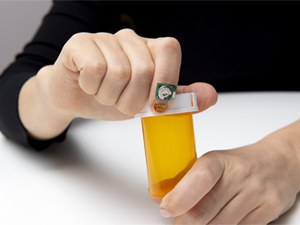



Date:25/12/18
 IBM Research has created a tiny fingernail sensor designed to help clinicians detect and monitor disease and movement disorders through AI analysis of grip strength.
IBM Research has created a tiny fingernail sensor designed to help clinicians detect and monitor disease and movement disorders through AI analysis of grip strength.
The new research was published in Scientific Reports. The gizmo is essentially a wearable strain sensor that interprets the kinematics of deformation in human fingernails. Put more simply, it sits on your fingernail from where it analyzes how the nail bends and moves.
The strain gauges allow the little wearable to detect longitudinal and lateral warpage on the order of single microns. For comparison purposes, each hair on your head measures some 70 microns. A particle of fog can range from five to fifty microns which means it’s largely invisible as we can only see somewhere in the range of 40 microns.
The average person uses their hands to grip objects thousands of times per day. Run this raw data through an accompanying smartphone app, smartwatch or other device, and you’re able to identify motions and gestures, finger-writing, grip strength and more.
The wearable device can be used to measure the effort needed to conduct everyday activities such as brushing your teeth, turning a key or opening a jar. Machine learning identifies patterns in the pressure, motion, grip strength, tremors and other symptoms. This can then be used to provide revealing insights into a broad set of health issues.
You could, for example, measure the progression of Parkinson’s disease, gauge cognitive abilities in schizophrenics or keep tabs on a person’s heart health. In fact, the project began as an attempt to capture the medication state of people with Parkinson’s disease but is now finding broader use. IBM says the technology can even be used to accurately detect finger-written digits which can help with identifying cognitive abilities.
The wearable is only in prototype stage, but the hope is that it will one day be used to help clinicians monitor patients conditions in their natural environments. IBM has not reveled yet on when the sensor might become a real-world product.
IBM’s tiny fingernail sensor monitors diseases & movement disorders
 IBM Research has created a tiny fingernail sensor designed to help clinicians detect and monitor disease and movement disorders through AI analysis of grip strength.
IBM Research has created a tiny fingernail sensor designed to help clinicians detect and monitor disease and movement disorders through AI analysis of grip strength.The new research was published in Scientific Reports. The gizmo is essentially a wearable strain sensor that interprets the kinematics of deformation in human fingernails. Put more simply, it sits on your fingernail from where it analyzes how the nail bends and moves.
The strain gauges allow the little wearable to detect longitudinal and lateral warpage on the order of single microns. For comparison purposes, each hair on your head measures some 70 microns. A particle of fog can range from five to fifty microns which means it’s largely invisible as we can only see somewhere in the range of 40 microns.
The average person uses their hands to grip objects thousands of times per day. Run this raw data through an accompanying smartphone app, smartwatch or other device, and you’re able to identify motions and gestures, finger-writing, grip strength and more.
The wearable device can be used to measure the effort needed to conduct everyday activities such as brushing your teeth, turning a key or opening a jar. Machine learning identifies patterns in the pressure, motion, grip strength, tremors and other symptoms. This can then be used to provide revealing insights into a broad set of health issues.
You could, for example, measure the progression of Parkinson’s disease, gauge cognitive abilities in schizophrenics or keep tabs on a person’s heart health. In fact, the project began as an attempt to capture the medication state of people with Parkinson’s disease but is now finding broader use. IBM says the technology can even be used to accurately detect finger-written digits which can help with identifying cognitive abilities.
The wearable is only in prototype stage, but the hope is that it will one day be used to help clinicians monitor patients conditions in their natural environments. IBM has not reveled yet on when the sensor might become a real-world product.
Views: 490
©ictnews.az. All rights reserved.Similar news
- Azerbaijani project to monitor disease via mobile phones
- Innovative educational system to be improved under presidential decree
- NTRC prolongs license of two TV and radio organizations for 6 years
- Azerbaijan establishes e-registry for medicines
- Azerbaijani museum introduces e-guide
- Nar Mobile opens “Nar Dunyasi” sales and service center in Siyazan city
- International conference on custom electronic services held in Baku
- OIC secretary general to attend COMSTECH meeting in Baku
- Azerbaijan develops earthquake warning system
- New law to regulate transition to digital broadcasting in Azerbaijan
- Azerbaijani State Social Protection Fund introduces electronic digital signature
- Intellectual traffic management system in Baku to be commissioned in December
- Tax Ministry of Azerbaijan started receiving video-addresses
- World Bank recommends Azerbaijan to speed up e-service introduction in real estate
- Azerbaijan to shift to electronic registration of real estate





















